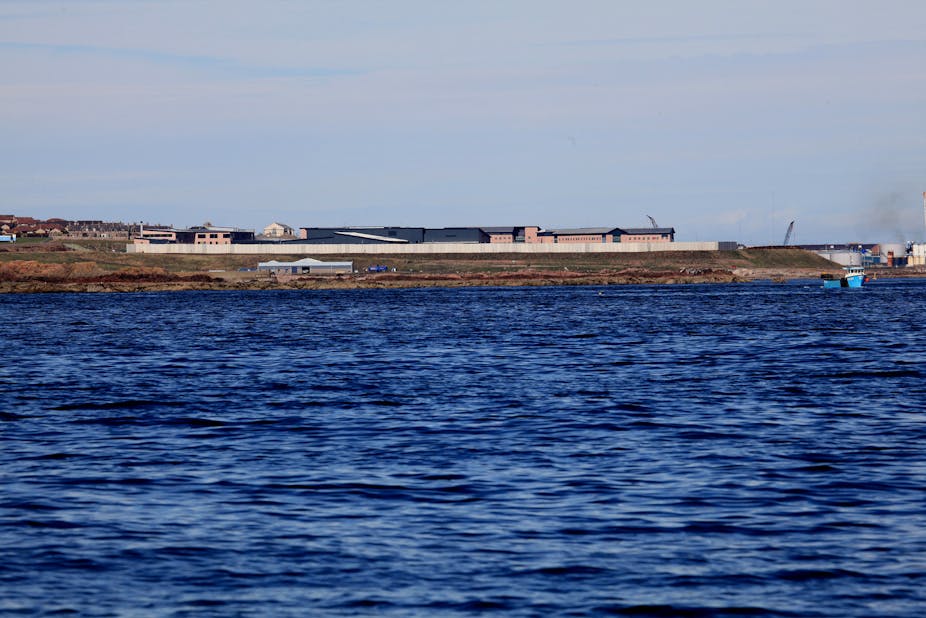HMP Grampian, which opened in March, lies on the southern side of the fishing port of Peterhead. This is high on the north-east Scottish coast, more than 50km north of Aberdeen.
It is a public project and a local prison in an age where privatisation and centralisation still have widespread policy sway. It represents the ambition of a Nationalist government seeking to do punishment differently, and specifically, differently from England.
The design of the £140 million prison has been described by its architects and the Scottish Prison Service as an exemplary template which will be used to guide future penal construction. It features a modern look inside and out, drawing inspiration from Norwegian prison designs with their natural light, painted walls and consideration for living space. With an aspiration to be a “community-facing” prison, it stands in stark contrast to the brutalism of traditional British jails.
The prison composition will also be a departure from the usual way of doing things. Its 550 cells will hold people of all sentence lengths, genders and ages. The only requirement is that they come from the north east of the country, favouring family proximity over segregation in distant specialist facilities.
Goodbye Aberdeen, goodbye Peterhead
HMP Grampian replaces its two 19th century precursors, HMP Aberdeen and HMP Peterhead, both of which have closed recently. Peterhead became infamous as the site of hostage takings and other disorder in previous decades. More recently it has been known for being Scotland’s only dedicated establishment for men convicted of sexual crimes, with specialist programmes designed for them.
Aberdeen prison was the local jail, holding those from the area who were awaiting trial or serving shorter sentences. The two prisons shared an architecture and aesthetic of Victorian control, ornamented buildings of civic pride. By the 21st century they had aged into decayed fortresses accreted by portable buildings and ever more layers of fencing, razor wire and peeling paint.
Grampian combines these two prisons into a single campus adjacent to the site of the old Peterhead prison. The location of this new prison in an economically marginal small town as opposed to the larger urban centre of Aberdeen, from which it is estimated 70% of the prisoners will come, generated some political dispute. This was fuelled partly by the fact that the local MSP for Peterhead also happens to be First Minister Alex Salmond.
So HMP Grampian is a crossroads of many stories: of local and national politics, history and the future of punishment, economics and community. Enterprises are to be given space to train the prison’s residents in local industries, in what are described as “employability partnerships”. By generating local jobs, it aims to change not only the lives of its inmates but also the community in which it sits.
Radical experiment
It will also be a purpose-built space for prison staff to implement their new service approach, a major organisational cultural change spearheaded by an activist chief executive, Colin McConnell. This is the “unlocking potential/transforming lives” agenda, a strategy that was introduced in late 2013 and informed by a movement within offender rehabilitation called “desistance”. This is about shifting away from the traditional “deficits-based” approach of identifying what’s wrong with offenders and fixing it; towards an “assets-based” model of identifying offenders’ strengths and building on them.
In keeping with the aspirations for the prison itself and the wider nation, the aim for the offenders is to focus on the positives, to build up social solidarity through community linkages and to look for inspiration from role models in Scandinavia. Norwegian reoffending rates appear much lower than in Scotland, albeit there is some debate over the comparability of the figures.
But this feels as much like a statement of national identity as an attempt to improve rehabilitation. As an expression of values, HMP Grampian could not be further removed from the direction penal policy and architecture is taking in England and Wales. There, as in the US, there remains an unquestioning faith in the efficiencies of megaprisons containing groups segregated by security level in brutalist boxes and removed from places where people live.
HMP Grampian offers a chance to think about the future of prison and of punishment, and to consider whether a prison ever can transcend its most basic function as a secure warehouse. But will it be any different in its effects? Will its humane architecture give way over time to rules and security devices that overwhelm its community-facing, strength-building dreams? Will it become the carbuncle akin to the prisons it has replaced?
Certainly the Scottish government has only gone some way towards copying Scandinavia. Grampian might look a bit more like a Norwegian prison, but Scottish prison populations still average more 300 compared to about 75 in those of its northern neighbour. We have seen numerous false dawns before, where ambitions to cut prison populations have seen rises instead. There are some who will question whether what really lies behind the new prison is a move to replace two old prisons with one efficient new one and save money in the process.
At the very least, though, HMP Grampian looks like a step in the right direction. And as psychological statements of separatist intent go, this is as notable as any.

